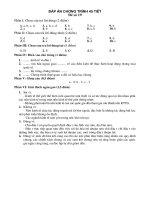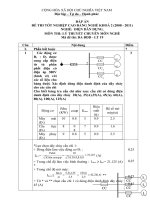PASSAGE 19
Bạn đang xem bản rút gọn của tài liệu. Xem và tải ngay bản đầy đủ của tài liệu tại đây (47.13 KB, 4 trang )
PASSAGE 19
Parents, teachers, and others who deal closely with teenagers know how difficult the adolescent years can
be. Adolescents have always been known to do wild, even dangerous, things. This was thought to be due
to the “foolishness of youth”. Now, brain-imaging technology allows scientists study the physical
development of the brain in more detail than ever before.
Recently, scientists discovered that though our brains are almost at their full size by the age of six, they
are far from fully developed. During adolescence, our brains go through great changes, like a computer
being upgraded. Such changes make us better at balancing impulses with following rules. But a stilldeveloping brain does this clumsily. The result, scientists claim, is the unpredictable behavior seen in
teens. The studies confirm that teens are more likely to take risks and behave in extreme ways.
Fortunately, the news isn’t all negative. As brain scientists point out, the teen brain inspires such
behavior in order to help teens prepare for adult life.
One way the brain does this is by changing the way teens measure risk and reward. When teens think
about rewards, their brain release more of the chemicals that create pleasure than an adult brain would.
This makes the rewards seem more important than the risks, and make teens feel the excitement of new
experiences more keenly than adults do.
Research into the structure of the teen brain also found that it makes social connections seenm especially
rewarding. As teens, we begin to realize our peers may one day control the world we live in. In this way,
the brain encourages teens to have a wide circle of friends, which is believed to make us more successful
in life.
Unfortunately, this hunt for greater rewards can sometimes lead teens to make bad decisions. However, it
also means that teens are more likely, and less afraid, to try new things or to be independent. The
scientists’ findings suggest that in the long run, the impulses of the teen brain are what help teens leave
their parents’ care and live their own lives successfully.
Question 1. The following sentence would best be placed at the end of which paragraph?
So teen are always searching for an experience that is more exciting than the last.
A. paragraph 1
B. paragraph 2
C. paragraph 3
D. paragraph 4
Question 2. Which of these statements about an adolescent’s brain is NOT true?
A. It is almost at its full size.
B. It is going through a lot of changes.
C. It does some things in a clumsy way
D. It is better than an adult brain at following rules
Question 3. What does the author mean by the phrase “the news isn’t all negative”?
A. Many teenagers are able to change their behavior.
B. The negative side of the research is not understood.
C. The way the teen brain works has some advantages.
D. The impulse of a teenage brain should be controlled.
Question 4. The phrase “more keenly” in paragraph 2 is closest in meaning to _________.
A. more strongly
B. more loudy
C. more slowly
D. more strangely
Question 5. What leads teens to meet new people?
A. the fear of being alone
B. the need to control others
C. the desire to leave home sooner
D. the excitement of new experiences
Question 6. What could happen if a teenager doesn’t socialize?
Page 1
A. the teen’s brain may stop developing.
B. The teen’s brain may develop badly.
C. The teen may not take as many risks.
D. The teen may miss contacts needed for future success.
Question 7. Which of the following would be the best heading for the last paragraph?
A. Finished brain
B. The Reward of Friendship
C. The Parents’ Role
D. How a Teen Makes Friend
Question 8. Which of the following claims is only a prediction of researchers?
A. A person’s brain reaches almost its full size by the age of six.
B. Teenagers are more likely to take risks and behave in extreme ways.
C. Brains go through many changes during adolescence.
D. To teens, social connections are rewarding.
ĐÁP ÁN
1-B
2-D
3-A
6-D
7-A
8-D
4-C
5-C
LỜI GIẢI CHI TIẾT
Question 1:
Câu dưới đây thích hợp đặt ở cuối đoạn văn nào nhất?
“ Vì vậy giới trẻ ln ln tìm kiếm cho mình một trải nghiệm thú vị hơn so với quá khứ”
Dẫn chứng: One way the brain does this is by changing the way teens measure risk and reward. When
teens think about rewards, their brain release more of the chemicals that create pleasure than an adult
brain would.
Dịch: Một cách để não bộ thực hiện điều đó là thay đổi cách mà thanh thiếu niên đo lường rủi ro và phần
thưởng. Khi giới trẻ nghĩ đến phần thưởng, não bộ có thể sản sinh ra các chất tạo khối cảm hơn não của
người trưởng thành => Nên đặt câu trên ở cuối đoạn 2 vì các ý ở đoạn văn 3 có thể làm minh chứng cho
câu đó.
Question 2:
Câu nào dưới đây khơng đúng khi nói về não của thanh thiếu niên?
A. Nó gần như phát triển đầy đủ kích thước
B. Nó đã trải qua rất nhiều thay đổi
C. Nó thực hiện một số việc một cách vụng về
D. Sẽ tốt hơn não của người lớn theo một số quy tắc
=> Dẫn chứng: Such changes make us better at balancing impulses with following rules.
Dịch: Những thay đổi này sẽ giúp chúng ta cân bằng các xung tốt hơn theo một số quy tắc.
Question 3:
Ý của nhà văn khi nói “ tin tức không phải tất cả đều là tiêu cực” là gì?
A. Nhiều thanh thiếu niên có thể thay đổi đổi hành vi của họ
B. Không hiểu được mặt tiêu cực của nghiên cứu
Page 2
C. Cách thức hoạt động của não đem lại một vài lợi ích
D. Cần kiểm sốt các xung của não thiếu niên
=> Dẫn chứng: Fortunately, the news isn’t all negative. As brain scientists point out, the teen brain
inspires such behavior in order to help teens prepare for adult life.
Dịch: May mắn thay, tin tức tất cả không phải đều là tiêu cực. Các nhà khoa học não chỉ ra rằng, não của
thanh thiếu niên có thể truyền cảm hứng cho các hành vi để giúp chuẩn bị cho cuộc sống trưởng thành của
họ
Question 4:
More keenly ( sâu sắc hơn) = more slowly ( chậm rãi, chi tiết hơn)
Question 5:
Điều gì dẫn đến thanh thiếu niên gặp người mới?
A. nỗi sợ hãi khi ở một mình
B. cần kiểm sốt người khác
C. mong muốn rời khỏi nhà sớm hơn
D. sự phấn khích của những trải nghiệm mới mẻ
=> Dẫn chứng: The scientists’ findings suggest that in the long run, the impulses of the teen brain are
what help teens leave their parents’ care and live their own lives successfully.
Dich: Các phát hiện của các nhà khoa học cho thấy về lâu dài, các xung động của não thiếu niên là thứ
giúp thanh thiếu niên rời khỏi cha mẹ của họ và chăm sóc cuộc sống của chính họ thành cơng.
Question 6:
Điều gì có thể xảy ra nếu một thiếu niên không giao tiếp xã hội?
A. não thiếu niên có thể ngừng phát triển.
B. Não thiếu niên có thể phát triển kém.
C. Thiếu niên có thể khơng gặp nhiều rủi ro.
D. Thiếu niên có thể bỏ lỡ các liên hệ cần thiết cho thành công trong tương lai.
=> Dẫn chứng: As teens, we begin to realize our peers may one day control the world we live in. In this
way, the brain encourages teens to have a wide circle of friends, which is believed to make us more
successful in life.
Dịch: Khi còn là thanh thiếu niên, chúng ta bắt đầu nhận ra đồng nghiệp của mình một ngày nào đó có thể
kiểm sốt thế giới chúng ta đang sống. Bằng cách này, bộ não khuyến khích thanh thiếu niên có một
nhóm bạn rộng, được cho là giúp chúng ta thành công hơn trong cuộc sống
Question 7:
Điều nào sau đây sẽ là tiêu đề tốt nhất cho đoạn cuối?
A. Hồn thành não
B. Phần thưởng của tình bạn
C. Vai trò của cha mẹ
D. Làm thế nào một thiếu niên kết bạn
=> Dẫn chứng: Unfortunately, this hunt for greater rewards can sometimes lead teens to make bad
decisions. However, it also means that teens are more likely, and less afraid, to try new things or to be
Page 3
independent. The scientists’ findings suggest that in the long run, the impulses of the teen brain are what
help teens leave their parents’ care and live their own lives successfully.
Dịch: Thật khơng may, việc săn tìm phần thưởng lớn hơn này đơi khi có thể khiến thanh thiếu niên đưa ra
quyết định tồi tệ. Tuy nhiên, điều đó cũng có nghĩa là thanh thiếu niên có nhiều khả năng và ít sợ hãi hơn
khi thử những điều mới hoặc tự lập. Các phát hiện của các nhà khoa học cho thấy về lâu dài, các xung
động của não thiếu niên là thứ giúp thanh thiếu niên rời khỏi cha mẹ của họ và chăm sóc cuộc sống của
chính họ thành cơng.
Question 8:
Khẳng định nào sau đây chỉ là dự đoán của các nhà nghiên cứu?
A. Một người não bộ đạt đến kích thước gần như đầy đủ khi lên sáu tuổi.
B. Thanh thiếu niên có nhiều khả năng chấp nhận rủi ro và hành xử theo những cách cực đoan.
C. Não bộ trải qua nhiều thay đổi trong thời niên thiếu.
D. Đối với thanh thiếu niên, các kết nối xã hội là bổ ích.
=> Dẫn chứng: The scientists’ findings suggest that in the long run, the impulses of the teen brain are
what help teens leave their parents’ care and live their own lives successfully.
Dịch: Các phát hiện của các nhà khoa học gợi ý về lâu dài, các xung động của não thiếu niên là thứ giúp
thanh thiếu niên rời khỏi cha mẹ của họ và chăm sóc cuộc sống của chính họ thành cơng.
Page 4









